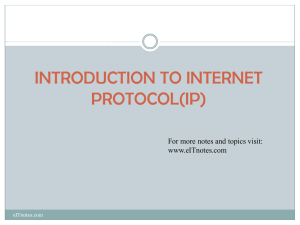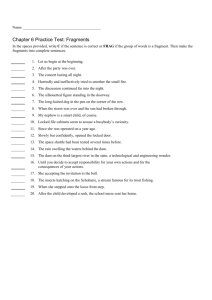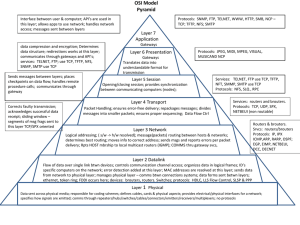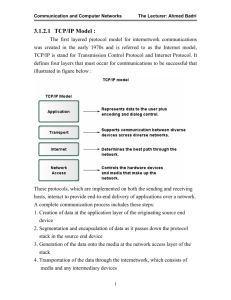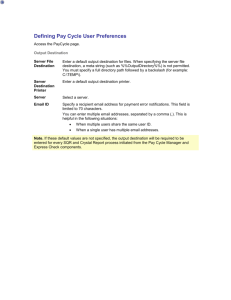FINAL EXAM
advertisement
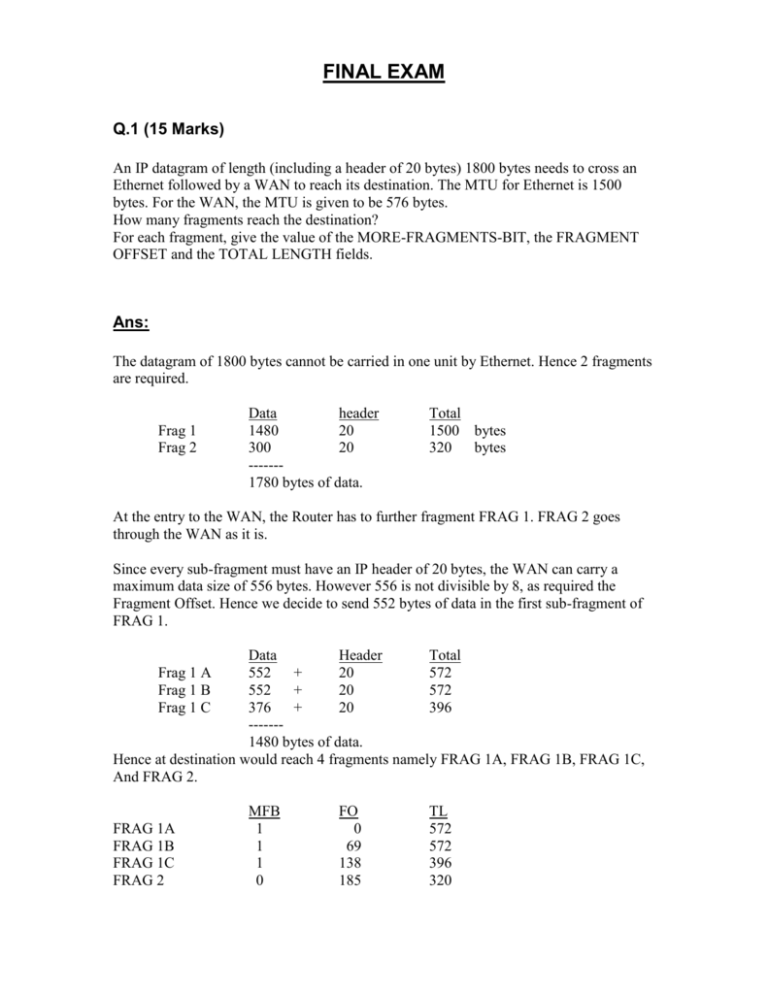
FINAL EXAM Q.1 (15 Marks) An IP datagram of length (including a header of 20 bytes) 1800 bytes needs to cross an Ethernet followed by a WAN to reach its destination. The MTU for Ethernet is 1500 bytes. For the WAN, the MTU is given to be 576 bytes. How many fragments reach the destination? For each fragment, give the value of the MORE-FRAGMENTS-BIT, the FRAGMENT OFFSET and the TOTAL LENGTH fields. Ans: The datagram of 1800 bytes cannot be carried in one unit by Ethernet. Hence 2 fragments are required. Frag 1 Frag 2 Data header 1480 20 300 20 ------1780 bytes of data. Total 1500 bytes 320 bytes At the entry to the WAN, the Router has to further fragment FRAG 1. FRAG 2 goes through the WAN as it is. Since every sub-fragment must have an IP header of 20 bytes, the WAN can carry a maximum data size of 556 bytes. However 556 is not divisible by 8, as required the Fragment Offset. Hence we decide to send 552 bytes of data in the first sub-fragment of FRAG 1. Data Header Total Frag 1 A 552 + 20 572 Frag 1 B 552 + 20 572 Frag 1 C 376 + 20 396 ------1480 bytes of data. Hence at destination would reach 4 fragments namely FRAG 1A, FRAG 1B, FRAG 1C, And FRAG 2. FRAG 1A FRAG 1B FRAG 1C FRAG 2 MFB 1 1 1 0 FO 0 69 138 185 TL 572 572 396 320 Q.2 (20 Marks) a) Describe the extra Hops Problem. b) Does an Exterior Router use EGP to exchange reachability information with interior routers? Why is the IP source network specified in an EGP routing update message? c) What are core Routers? Can the Core Routing Architecture be partitioned into two sets of routers that keep partial information and use default routes? d) A set of routers R1, R2 and R3 use Vector Distance Routing. Some of the entries in the routing table of R1 are as follows: Destination Net 15 Net 16 Net 17 Distance 5 3 8 Route R2 R3 R2 R1 does not have any entry for Net 19. R2 sends an update message to R1. The message contains the following items: Destination Net 15 Net 16 Net 17 Net 19 Distance 4 1 5 2 What changes will R1 make in its routing table? Ans: 2(a): Extra Hops Problem The viewpoint of the core system as a Central Routing Mechanism to which noncore routers can send datagrams for delivery in a larger Internet where the No. of CORE ROUTERS < No. of networks leads to the problem. Thus Diagram N1 local net R1 Back Bone R2 N2 local net R3 Non core Router Suppose R3 thinks of the core as a delivery system and chooses R1 to deliver datagrams to all those networks, which are not directly connected to R3. Then any datagram for a host in a network like N2 (except for those for host in N1) will require an extra hop. Only the destinations that lie beyond R1 have optimal routes. All paths that go through other backbones, routers require an extra hop. 2(b): The fields IP source network specifies a network common to the two autonomous system to which the two neighboring exterior routers of the two systems attached. The response will contain routes that have distances measured with respect to routers on the specified source network. Two reasons for specifying a source network: 1: A router as always connected to more than one physical networks and application which implements LCP on a router, it may not know over which network interface, The ECP request arrives. Therefore it may not know to which network the request refers. 2: When advertising network, the request refers. Exterior routers send its neighbors a set of pairs, each pair specifies: -A destination net in the autonomous system and -The router used to reach the destination. The router used to reach a destination depends upon where the external traffic enters the autonomous system. The source network specifies the point, at which the packet enters the autonomous system. 2(c) Core routers provides reliable, consistant and authoritative routes for all possible destinations on the ehternet . It is not possible to partition the core system into subsets that each keep partial information without loosing functionality. Diagram default routes from sites behind core1 default routes from sites Core 1 Core 2 behind core2 For example in the above fig. An illegally addressed datagram will cycle between the two partitions in a routing loop till TTL becomes 0. Hence partially informed core routes may lead to the routing loops. So these are not used. 2(d) Dest (+ Distance Route Net 16 Net 17 Net 19 2 6 3 R2 R2 R2 Net 15 5 R2) Q.3(20 marks): A: What are the advantages of doing reassembly at the ultimate destination instead of doing it after the datagram travels across one network.? B: Why do we use protocol ports rather than process identifiers to specify the destination with in a machine? C: What do you understan by virtual circuit connection? D: How can you manage to send OUT OF BAND data in TCP, which is basically stream oriented? Ans: A: Routers need not bother about whether the datagram is fragment or not. The fragments may travel to the destination through different routes. B: Processes are created &destroyed dynamically. A sender there fore cannot identify the processes on the receiver machine. The receiver may replace processes (say by rebooting the machine) without informing all the senders. The need is to identify destinations from the functions they implement. A process may handle two or more functions simultaneously. C: In the beginning when an application is to send data to an application on another machine, TCP establishes the connection by confirming the sequence Number and other parameters like the maximum segment size between the TCP software packages at the sender and receiver. Then the application is informed that the connection has been established. As the data is sent , the TCP packages continue to exchange messages to verify that the data as being transferred correctly. In case of any failure in data transfer , the two packages detect it and inform th applications. At the end of data transfer , the connection is closed. Thus TCP provides an illusion of a physical connection between the two machine , even though the underlying protocol IP provides a connectionless delivery. D: The data which is to be sent OUT OF BAND ,is marked URGENT by setting the URG code bit and by putting the byte number upto which the data is urgent in the URGENT POINTER. The protocol requires : That the Receiving Program should be notified of the arrival of the URG data as soon as possible , regardless of the position of the data in the data stream, that the receiving Application Program then, should go into the Urgent Mode. After all the Urgent data as consumed ,TCP tells the application returns to the Normal Operation. QNO:4 (25 Marks) Please refer to fig 1 and 2: specify the value of each one the following fields in the Pseudo Header and the TCP segment: TCP segment: TCP SEGMENT LENGTH, TCP HEADER LENGTH, CHECKSUM Please specify the values in the decimal number system only: Given that Source port number =22, Destination port no= 4096 Sequence number=257, Acknowledge number =129, Window size = 131, Urgent pointer =0, Source IP address= 177.144.8.26, Destination IP address=177.144.8.2, Protocol=6 No option is used has been used. The segment is carrying no data. The values above are given in the decimal number system. the IP addresses are in dotted decimal notation. The code bits in binary are 010010. a): Fig1: Source port destination port Sequence number Acknowledgement number TCP Header Length U A P R S F R C S S Y I G K H T N N window size Check sum urgent pointer Option Data (optional) 32bits Source address Destination address 000 000 00 Protocol=6 ANS: TCP header length 5; TCP segment langth 20. Header : 0016 0000 0000 5012 0000 10 00 01 01 00 81 00 83 000 0 checksum = 2A68(16) !’s compliment of S TCP segment length Pseudoheader: B190 B190 0006 081A 0815 0014 =2*4096+10*256+6*16+8*1=10856 1’COMPLEMENT: 0016 1000 0101 0081 5012 0083 B190 081A B190 0815 0006 0014 1 D596 1~END ROUND CARRY S=D597 QNO:5(20 MARKS) 1: As packet goes through a router in th internet , which of the following fields are always modified? a. code bits and sequence number fields of TCP. b. UDP Source Port and UDP Check Sum fields c. IP Source Network and Status fields of EGP d. TTL and Check Sum fields of IP 2: A subnet mask tells us a. which bits of the IP address from the network address b. which bits are used to be used to calculate the checksum c. which bits of the Ip address donot change as the message message travels over the internet. d. Which part of the network is vulnerable to attacks from the hackers. 3: Subnetting and Supernetting techniques are used to help avoid a. congestion at router b. the runnig out of Address space problem c. overflow of buffer at the receiver d. effects of noise on data communication 4: which of the following is/are valid address which may be used to contact remote hosts on the internet? a. 127.0.0.0 b. 222.121.22.2 c. 221.121.321.421 d. 137.207.240.19 5: to avoid silly window syndrome problem , a software solution is required to be worked out. a. at the intermediate routers. b. In the physical layer of the software package c. In the application layer of the software package d. For setting the RST and PSH bits e. At both the sending end as well as at the receiving end. ANS: 1:d 2:a 3:b 4:d 5:e


